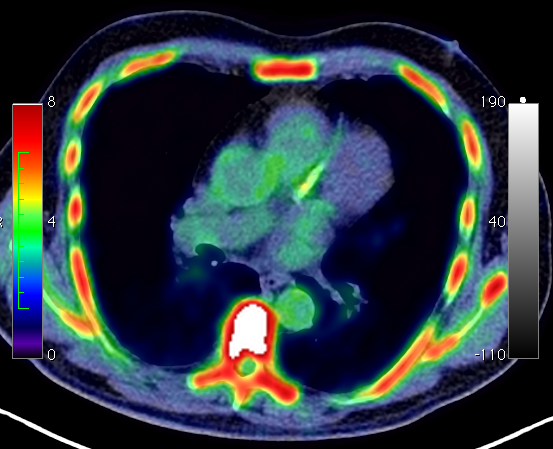
From left to right, CT, PET and combined PET/CT images of the heart arteries. The areas in white on the left and right panels demonstrate calcification of the arteries, whilst the orange spots on the middle and right panels demonstrate actively calcifying areas of atherosclerosis. These have accumulated significant amounts of NaF, and we believe that these areas represent high-risk areas for future heart attacks. Further work is, of course, needed to prove this hypothesis.
Building on work pioneered in Cambridge 10 years ago, scientists have developed a new imaging approach that could help improve how doctors predict a patient’s risk of having a heart attack.
The British Heart Foundation (BHF) funded project, a collaboration between scientists from the Universities of Cambridge and Edinburgh, is the first to demonstrate the potential of combined PET and CT imaging to highlight the disease processes causing heart attacks directly within the coronary arteries.
The research, published last week in the Journal of the American College of Cardiology (JACC), involved imaging over 100 people with a CT calcium scan to measure the amount of calcified or hardened plaques in their coronary arteries. This is a standard test, which is commonly used to predict heart attack risk but cannot distinguish calcium that has been there for some time from calcium that is actively building up.
The patients were also injected with two contrast agents that show up on PET imaging scans, and which can be used to track various metabolic pathways in the body. One of these tracers, 18F-sodium fluoride (18F-NaF), is a molecule taken up by cells in which active calcification is occurring. The 18F-NaF can then be visualised and quantified during a PET scan.
The researchers wanted to see if they could identify patients with active, ongoing calcification because these patients may be at higher risk of heart attack than patients in whom the calcium developed a long time ago. The results showed that increased 18F-NaF activity could be observed in specific coronary artery plaques in patients who had many other high-risk markers of cardiovascular disease.
Dr James Rudd, HEFCE Senior Lecturer at the Department of Medicine and joint senior author of the paper, said:
Our results show, for the first time, that certain areas of atherosclerosis within the coronary arteries, previously thought to be inert, are actually highly active and have the potential to cause heart attack. Once identified, they might be targeted with drug therapy more effectively.
Additionally, we might be able to improve our ability to predict an individual person’s future risk of heart attack using this fairly straightforward imaging test in selected people.
This research exploits longstanding scientific links between my research team in Cambridge and Professor Newby’s in Edinburgh, with core support from the Cambridge NIHR Biomedical Research Centre, HEFCE and the British Heart Foundation.
Dr Marc Dweck, lead author on the research paper and a BHF Clinical Research Fellow at the University of Edinburgh, said:
Predicting heart attacks is very difficult and the methods we’ve got now are good but not perfect. Our new technique holds a lot of promise as a means of improving heart attack prediction although further ongoing work is needed before it becomes routine clinical practice.
If we can identify patients at high risk of a heart attack earlier, we can then use intensive drug treatments, and perhaps procedures such as stents, to reduce the chances of them having a heart attack.
Dr Shannon Amoils, Research Advisor at the (BHF), which funded the study, said:
For decades cardiologists have been looking for ways to detect the high-risk plaques found in coronary arteries that could rupture to cause a heart attack, but it’s been difficult to develop a suitable imaging test that can focus in on these small vessels.
This research is a technical tour de force as it allows us to assess active calcification happening right in the problem area – inside the wall of the coronary arteries and this active calcification may correlate with a higher risk of a heart attack.
There are nearly 2.7 million people living with coronary heart disease (CHD) in the UK and it kills 88,000 people each year. Most of these deaths are caused by a heart attack. Each year there are around 124,000 heart attacks in the UK.
![Cocker J Nucl Cardiol 2012 Imaging atherosclerosis with hybrid [18F]fluorodeoxyglucose positron emission tomographycomputed tomography imaging What Leonardo da Vinci could not see.pdf (page 10 of 15).jpg Cocker J Nucl Cardiol 2012 Imaging atherosclerosis with hybrid 18F fluorodeoxyglucose positron emission tomographycomputed tomography imaging What Leonardo da Vinci could not see pdf page 10 of 15](https://static.squarespace.com/static/5002a5e1e4b074756d7a4350/52643324e4b00b6c2cf453b6/52643324e4b00b6c2cf4541a/1354221547377/1000w/Cocker%20J%20Nucl%20Cardiol%202012%20Imaging%20atherosclerosis%20with%20hybrid%20%5B18F%5Dfluorodeoxyglucose%20positron%20emission%20tomographycomputed%20tomography%20imaging%20What%20Leonardo%20da%20Vinci%20could%20not%20see.pdf%20(page%2010%20of%2015).jpg)

